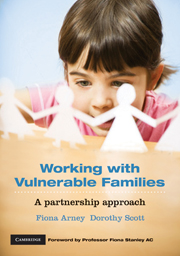Book contents
- Frontmatter
- Foreword
- Contents
- List of figures, tables and boxes
- Contributors
- Acknowledgements
- Introduction
- Chapter 1 Think child, think family, think community
- Chapter 2 Family strengths: an international perspective
- Chapter 3 Harnessing ‘resilience’ when working with children and families
- Chapter 4 Working within and between organisations
- Chapter 5 Family-centred practice in early childhood settings
- Chapter 6 Sustained nurse home visiting with families of Aboriginal children
- Chapter 7 Including fathers in work with vulnerable families
- Chapter 8 Parenting in a new culture: working with refugee families
- Chapter 9 Responding to parents with complex needs who are involved with statutory child protection services
- Chapter 10 Engaging family members in decision making in child welfare contexts
- Chapter 11 Supporting parents whose children are in out-of-home care
- Chapter 12 Using evidence-informed practice to support vulnerable families
- Chapter 13 Spreading promising ideas and innovations in child and family services
- Index
Chapter 3 - Harnessing ‘resilience’ when working with children and families
- Frontmatter
- Foreword
- Contents
- List of figures, tables and boxes
- Contributors
- Acknowledgements
- Introduction
- Chapter 1 Think child, think family, think community
- Chapter 2 Family strengths: an international perspective
- Chapter 3 Harnessing ‘resilience’ when working with children and families
- Chapter 4 Working within and between organisations
- Chapter 5 Family-centred practice in early childhood settings
- Chapter 6 Sustained nurse home visiting with families of Aboriginal children
- Chapter 7 Including fathers in work with vulnerable families
- Chapter 8 Parenting in a new culture: working with refugee families
- Chapter 9 Responding to parents with complex needs who are involved with statutory child protection services
- Chapter 10 Engaging family members in decision making in child welfare contexts
- Chapter 11 Supporting parents whose children are in out-of-home care
- Chapter 12 Using evidence-informed practice to support vulnerable families
- Chapter 13 Spreading promising ideas and innovations in child and family services
- Index
Summary
Learning goals
This chapter will enable you to:
Recognise how ‘resilience’ can highlight pathways and outcomes for vulnerable children and families
Consider how resilience might be best defined as an ongoing interaction between the person and their environment
Identify the risk and protective factors that underpin the process of resilience
Discover some of the practical applications that draw upon the concept of resilience
Understand the organisational and individual factors that can drive preferences for practice, including the likely practical uptake of concepts like ‘resilience’
Learn how resilience-based practice guidance might help organise the ways in which practitioners and organisations engage with vulnerable children and families.
Introduction
Working with vulnerable children and families is a complex and ongoing process. Since vulnerable families often have multiple and complex needs, practitioners who work with them need to try to address both immediate issues such as physical safety and shelter, alongside longer term needs such as promoting good parenting and enabling individual behaviour change away from problems such as drug and alcohol misuse. As the problems that families and children facing hardship endure are complex and multifaceted, practitioners cannot rely on any one single method or theory in their practice, but instead need to adopt a practice philosophy that is able to consider families' strengths, weaknesses, needs, challenges, and priorities in a holistic and coherent way.
- Type
- Chapter
- Information
- Working with Vulnerable FamiliesA Partnership Approach, pp. 49 - 70Publisher: Cambridge University PressPrint publication year: 2010
- 1
- Cited by

